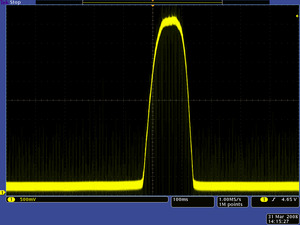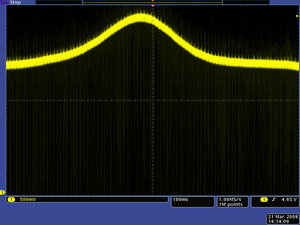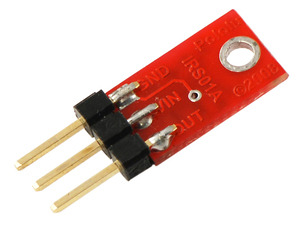The QTR-1A reflectance sensor carries a single infrared LED and phototransistor pair in an inexpensive, tiny 0.5" x 0.3" module that can be mounted almost anywhere and is great for edge detection and line following applications.
The reflectance measurement is output as an analog voltage.
Note: The QTR-1A reflectance sensor requires an analog input to take readings. The similar QTR-1RC reflectance sensor is available with a digital I/O-compatible output.
Functional Description
The Pololu QTR-1A reflectance sensor carries a single infrared LED and phototransistor pair. The phototransistor is connected to a pull-up resistor to form a voltage divider that produces an analog voltage output between 0 V and VIN (which is typically 5 V) as a function of the reflected IR. Lower output voltage is an indication of greater reflection.
The LED current-limiting resistor is set to deliver approximately 20-25 mA to the LED when VIN is 5 V. The current requirement can be met by some microcontroller I/O lines, allowing the sensor to be powered up and down through an I/O line to conserve power.
Because of its small size, multiple units can easily be arranged to fit various applications such as line sensing and proximity/edge detection. For a line sensor with eight of these units arranged in a row, please see the QTR-8A reflectance sensor array.
Specifications
- Dimensions: 0.3" x 0.5" x 0.1" (without header pins installed)
- Operating voltage: 5.0 V
- Supply current: 25 mA
- Output format: analog voltage
- Output voltage range: 0 to supplied voltage
- Optimal sensing distance: 0.125" (3 mm)
- Maximum recommended sensing distance: 0.25" (6 mm)
- Weight without header pins: 0.008 oz (0.23 g)
Interfacing with the QTR-1A Output
There are several ways you can interface with the QTR-1A output:
- Use a microcontroller's analog-to-digital converter (ADC) to measure the voltage.
- Use a comparator with an adjustable threshold to convert the analog voltage into a digital (i.e. black/white) signal that can be read by the digital I/O line of a microcontroller.
- Connect the output directly to the digital I/O line of a microcontroller and rely upon its internal comparator.
This last method will work if you are able to get high reflectance from your white surface as depicted in the left image, but will probably fail if you have a lower-reflectance signal profile like the one on the right.
|
 |
| QTR-1A output 1/8" away from a spinning white disk with a black line on it. |
|
|
 |
| QTR-1A output 3/8" away from a spinning white disk with a black line on it. |
|
Our Pololu AVR library provides functions that make it easy to use these sensors with our Orangutan robot controllers and other AVR-based controller boards such as Arduinos.
Included Components
This module has a single mounting hole intended for a #2 screw (not included); if this mounting hole is not needed, this portion of the PCB can be ground off to make the unit even smaller. The reflectance sensor ships with a 3-pin 0.1" header strip, which can be soldered in the conventional perpendicular orientation or parallel to the PCB, as shown below. You can also solder wires, such as ribbon cable, directly to the pads for the smallest installation.
 |
| An example of soldering header pins parallel to QTR-1A PCB for compact installation. |
Documentation and other information
File downloads
- Datasheet for Fairchild's QRE1113GR reflective object sensor(202k pdf)
- This is the sensor that we initially used in the Pololu QTR reflectance sensors, but we have since switched to a similar generic unit that has slightly longer range.
- How is the Pololu QTR-1A different from Parallax's QTI sensor?
- The main difference is in the output interface: the Pololu QTR-1A has an analog voltage output that typically requires an analog-to-digital converter (ADC). Our QTR-1RC is much more similar to the Parallax QTI sensor.
No recommended products at the moment.
No recommended products at the moment.